Abstract
The present paper is devoted to second- and higher-tier test methods for the characterization of behavioral changes produced in rodents by exposure to noxious agents during development. The paper analyzes a series of end points that are informative about specific processes and underlying regulatory mechanisms but require greater technical sophistication and larger investments than first-tier end points. This applies to ultrasonic emissions in successive postnatal periods; to mother-pup interactions, including appropriate cross-fostering controls; to social (including sexual) interaction tests from the infantile to the young adult stage; and to a variety of conditioning and learning tests using both positive and negative reinforcement.
Full text
PDF
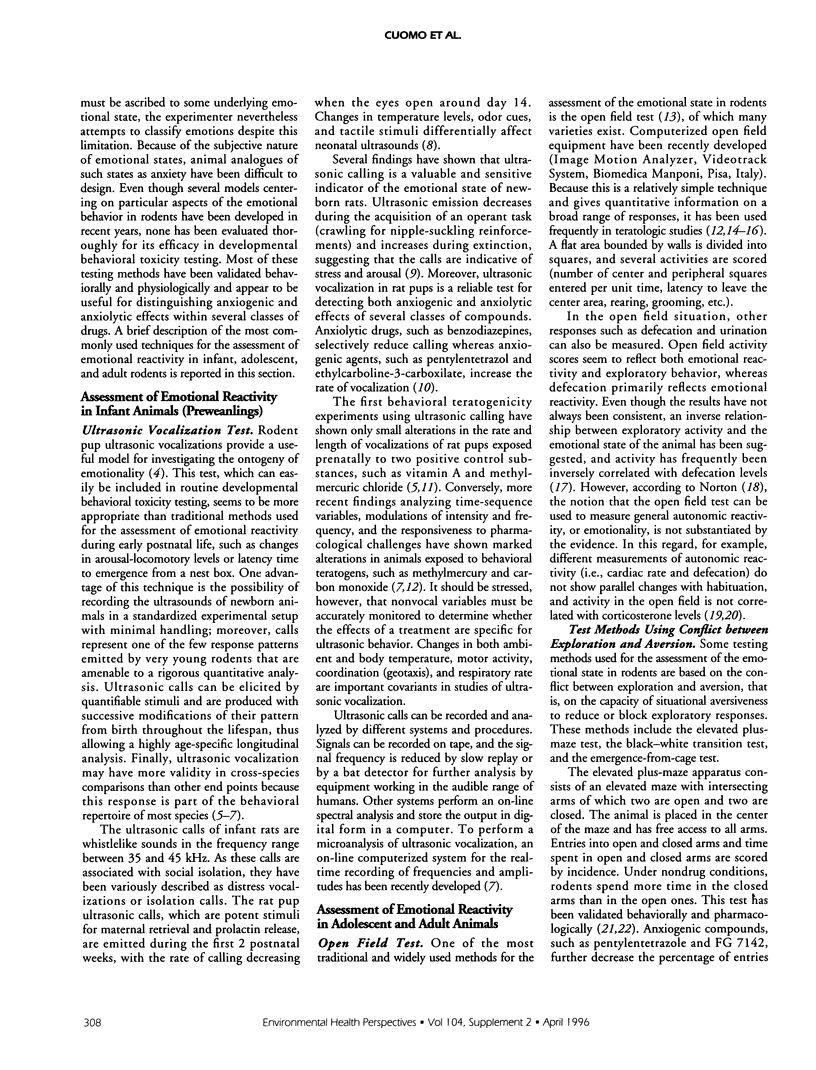
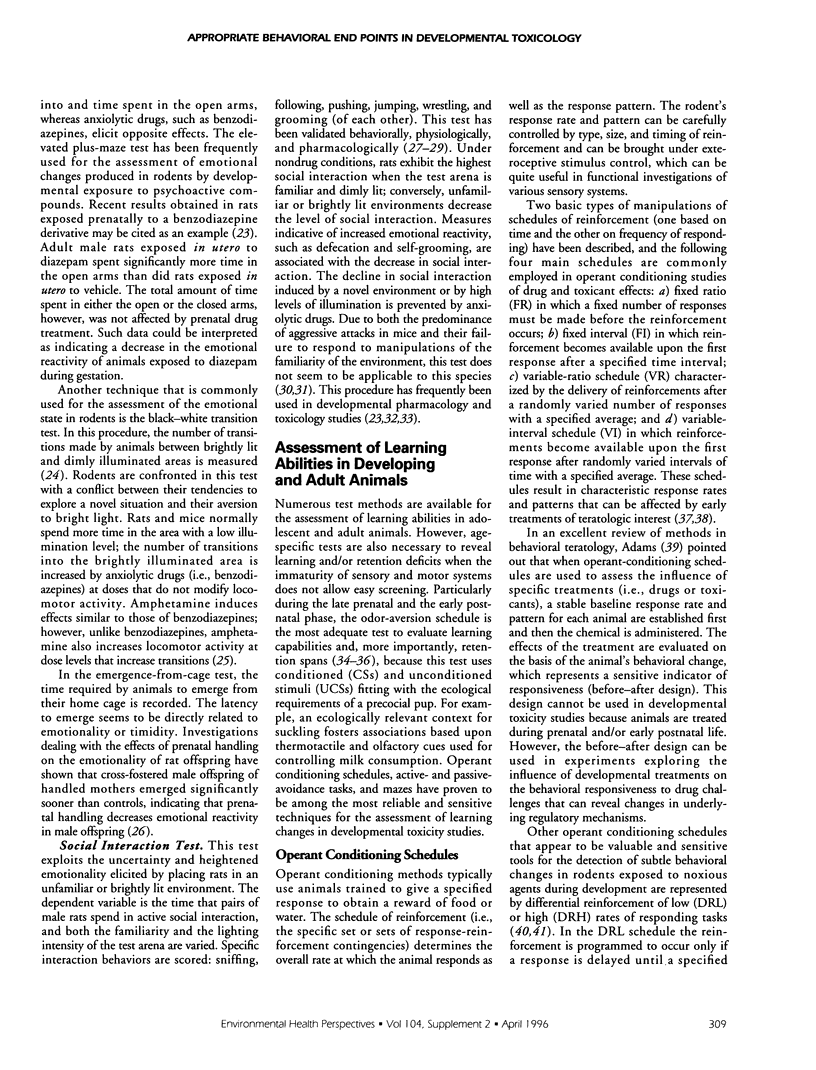
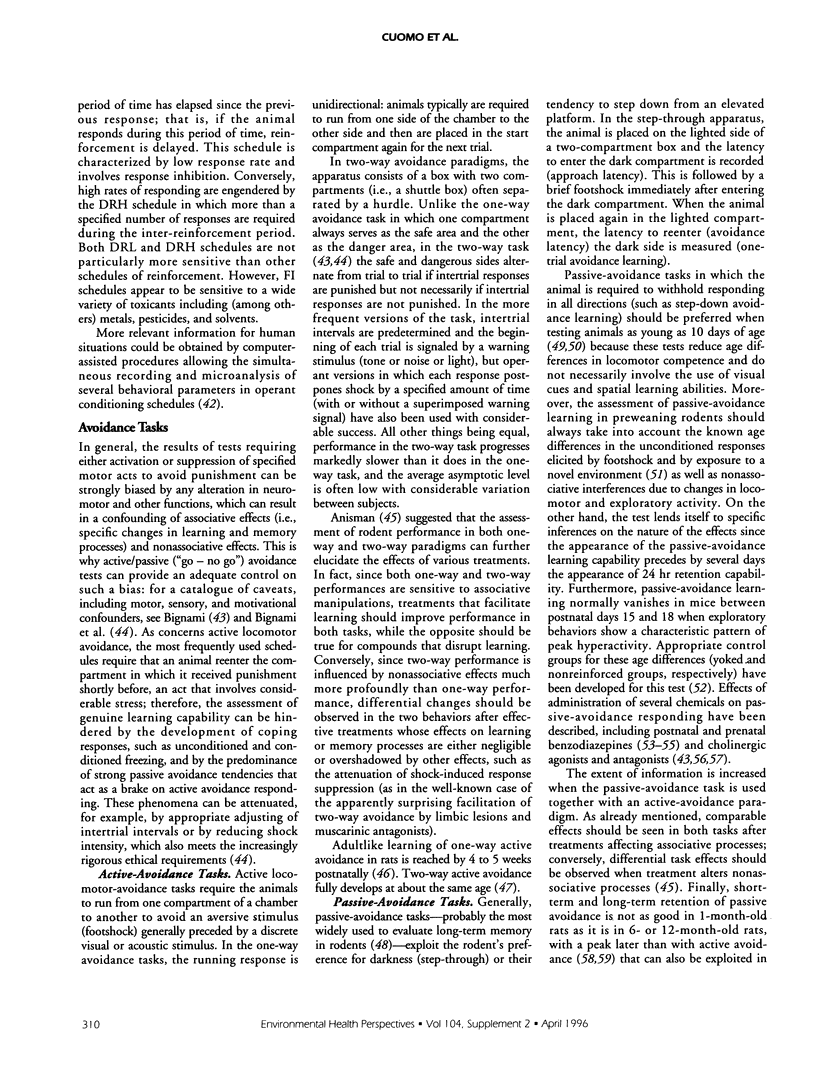
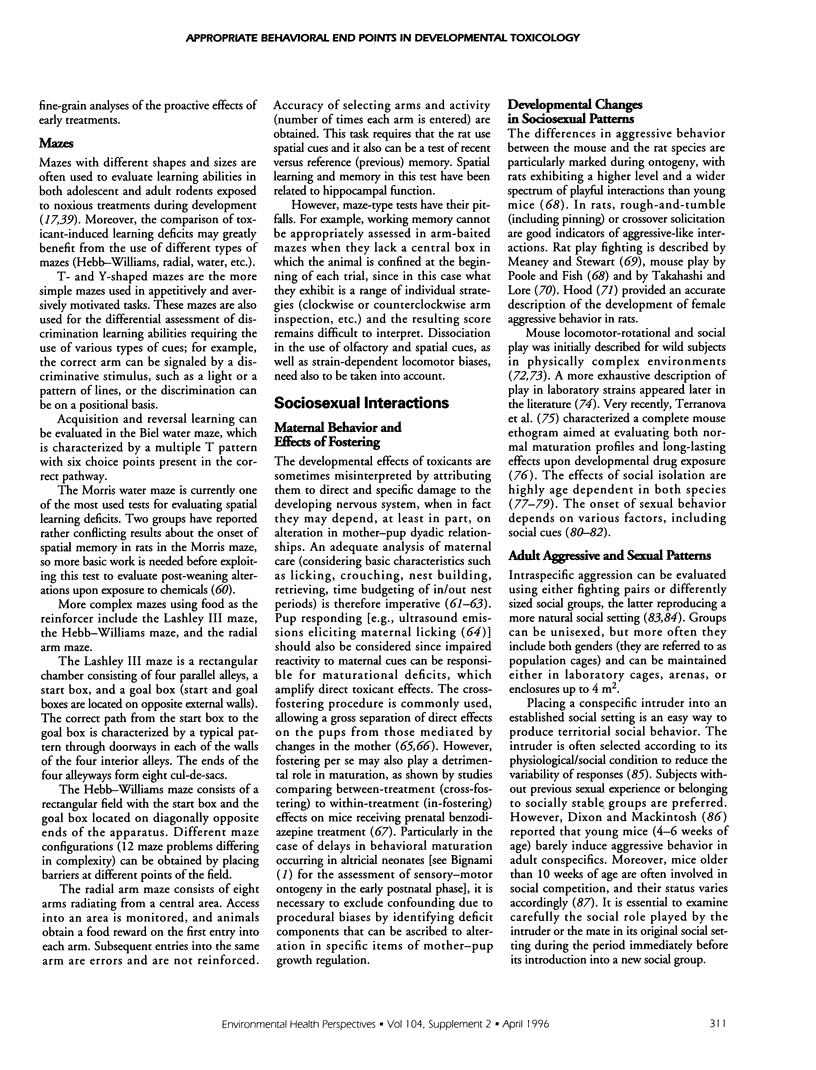
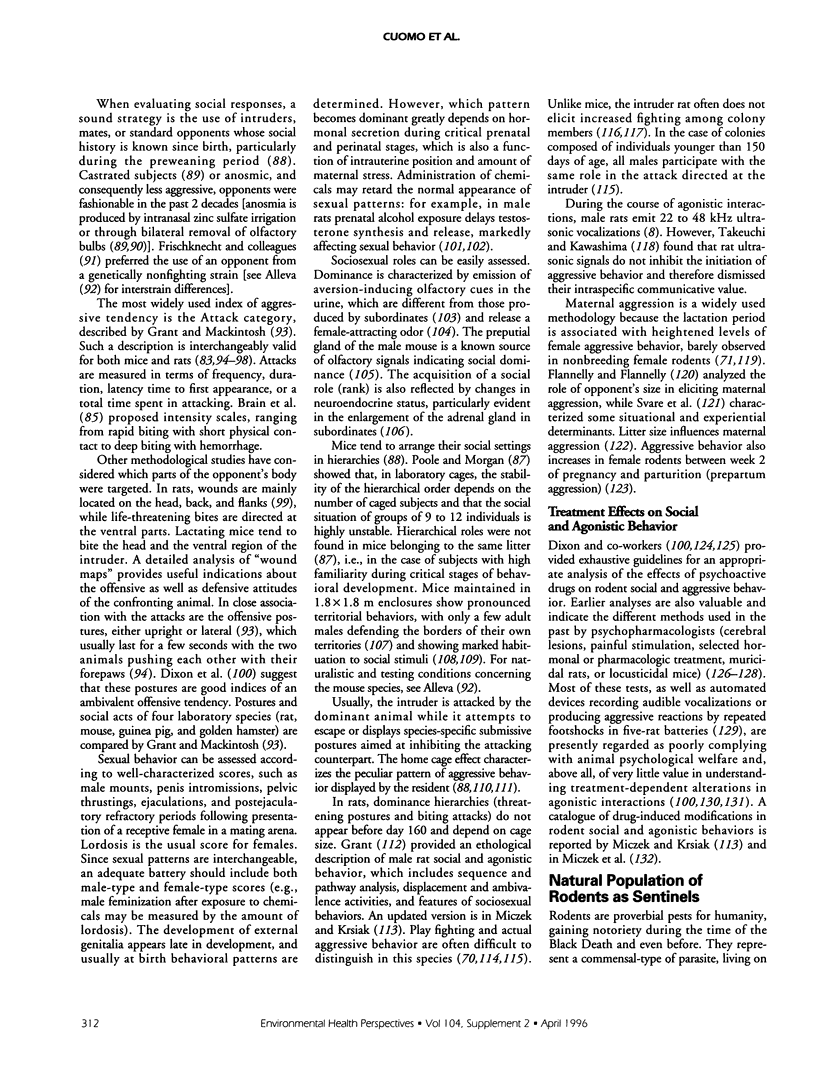
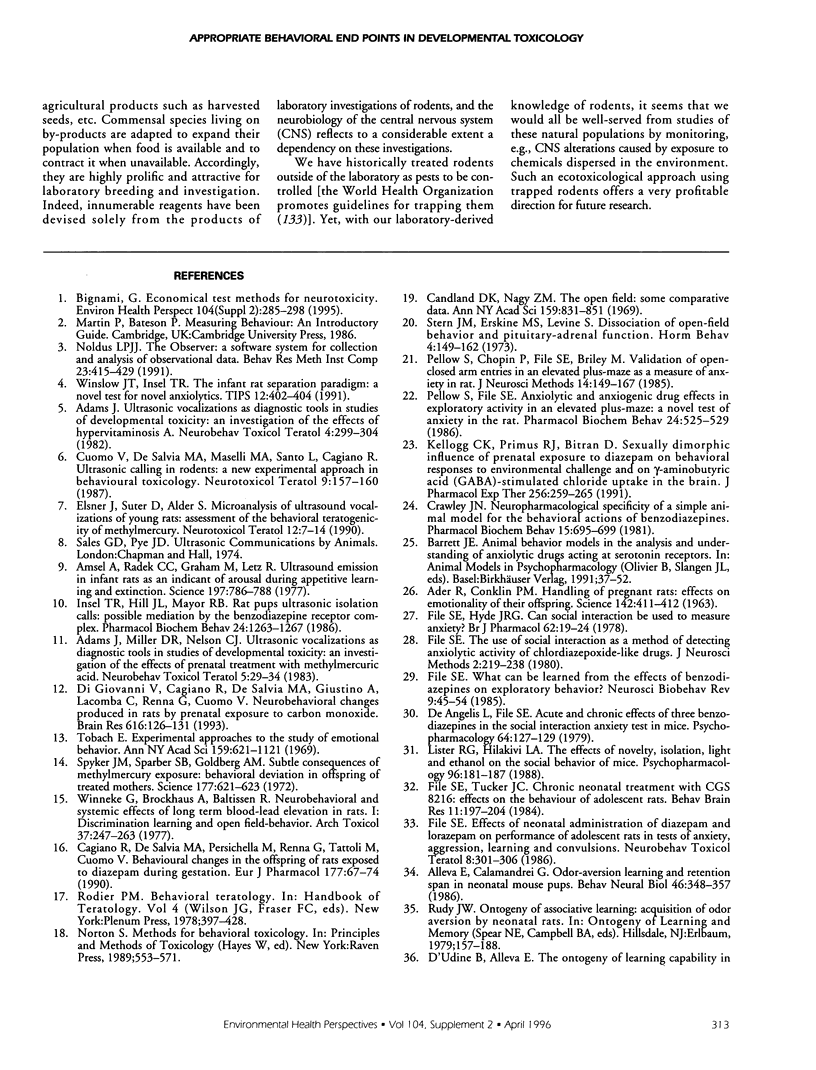
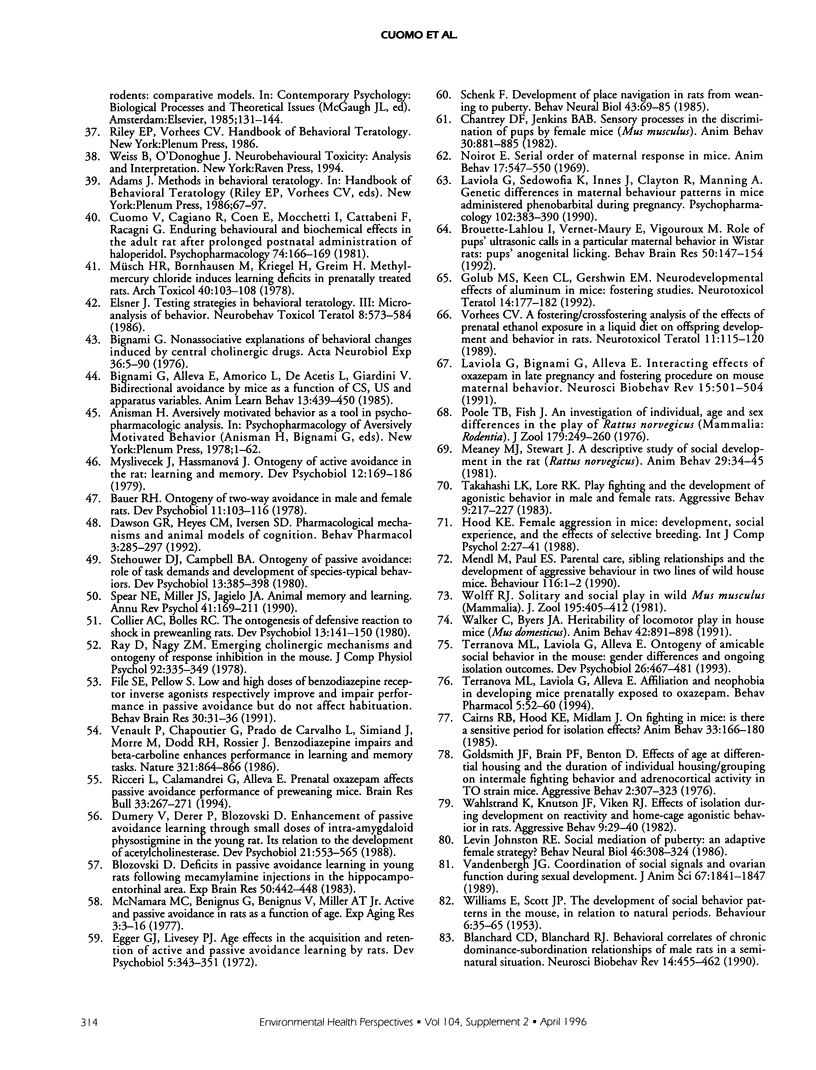
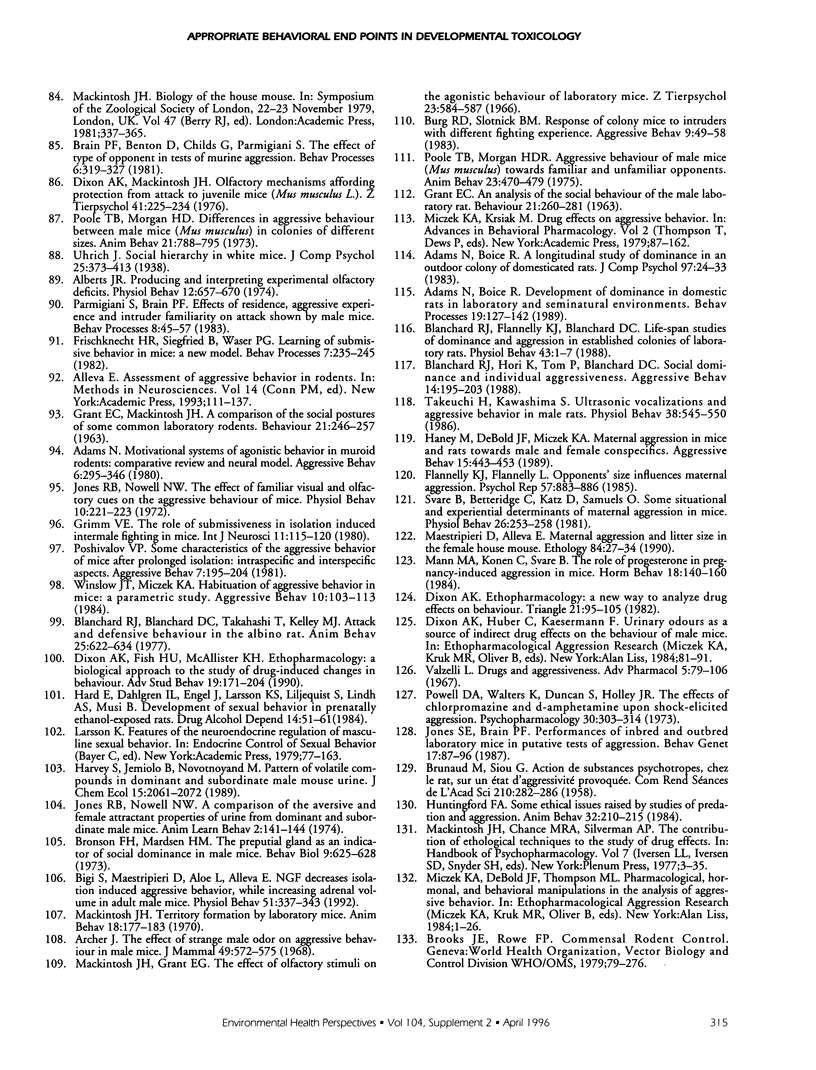
Selected References
These references are in PubMed. This may not be the complete list of references from this article.
- ADER R., CONKLIN P. M. HANDLING OF PREGNANT RATS: EFFECTS ON EMOTIONALITY OF THEIR OFFSPRING. Science. 1963 Oct 18;142(3590):411–412. doi: 10.1126/science.142.3590.411. [DOI] [PubMed] [Google Scholar]
- Adams J., Miller D. R., Nelson C. J. Ultrasonic vocalizations as diagnostic tools in studies of developmental toxicity: an investigation of the effects of prenatal treatment with methylmercuric chloride. Neurobehav Toxicol Teratol. 1983 Jan-Feb;5(1):29–34. [PubMed] [Google Scholar]
- Adams J. Ultrasonic vocalizations as diagnostic tools in studies of developmental toxicity: an investigation of the effects of hypervitaminosis A. Neurobehav Toxicol Teratol. 1982 May-Jun;4(3):299–304. [PubMed] [Google Scholar]
- Alberts J. R. Producing and interpreting experimental olfactory deficits. Physiol Behav. 1974 Apr;12(4):657–670. doi: 10.1016/0031-9384(74)90216-9. [DOI] [PubMed] [Google Scholar]
- Alleva E., Calamandrei G. Odor-aversion learning and retention span in neonatal mouse pups. Behav Neural Biol. 1986 Nov;46(3):348–357. doi: 10.1016/s0163-1047(86)90317-1. [DOI] [PubMed] [Google Scholar]
- Amsel A., Radek C. C., Graham M., Letz R. Ultrasound emission in infant rats as an indicant of arousal during appetitive learning and extinction. Science. 1977 Aug 19;197(4305):786–788. doi: 10.1126/science.560717. [DOI] [PubMed] [Google Scholar]
- Archer J. The effect of strange male odor on aggressive behavior in male mice. J Mammal. 1968 Aug;49(3):572–575. [PubMed] [Google Scholar]
- Bauer R. H. Ontogeny of two-way avoidance in male and female rats. Dev Psychobiol. 1978 Mar;11(2):103–116. doi: 10.1002/dev.420110203. [DOI] [PubMed] [Google Scholar]
- Bigi S., Maestripieri D., Aloe L., Alleva E. NGF decreases isolation-induced aggressive behavior, while increasing adrenal volume, in adult male mice. Physiol Behav. 1992 Feb;51(2):337–343. doi: 10.1016/0031-9384(92)90150-z. [DOI] [PubMed] [Google Scholar]
- Bignami G. Economical test methods for developmental neurobehavioral toxicity. Environ Health Perspect. 1996 Apr;104 (Suppl 2):285–298. doi: 10.1289/ehp.96104s2285. [DOI] [PMC free article] [PubMed] [Google Scholar]
- Bignami G. Nonassociative explanations of behavioral changes induced by central cholinergic drugs. Acta Neurobiol Exp (Wars) 1976;36(1-2):5–90. [PubMed] [Google Scholar]
- Blanchard D. C., Blanchard R. J. Behavioral correlates of chronic dominance-subordination relationships of male rats in a seminatural situation. Neurosci Biobehav Rev. 1990 Winter;14(4):455–462. doi: 10.1016/s0149-7634(05)80068-5. [DOI] [PubMed] [Google Scholar]
- Blanchard R. J., Blanchard D. C., Takahashi T., Kelley M. J. Attack and defensive behaviour in the albino rat. Anim Behav. 1977 Aug;25(3):622–634. doi: 10.1016/0003-3472(77)90113-0. [DOI] [PubMed] [Google Scholar]
- Blanchard R. J., Flannelly K. J., Blanchard D. C. Life-span studies of dominance and aggression in established colonies of laboratory rats. Physiol Behav. 1988;43(1):1–7. doi: 10.1016/0031-9384(88)90089-3. [DOI] [PubMed] [Google Scholar]
- Blozovski D. Deficits in passive avoidance learning in young rats following mecamylamine injections in the hippocampo-entorhinal area. Exp Brain Res. 1983;50(2-3):442–448. doi: 10.1007/BF00239211. [DOI] [PubMed] [Google Scholar]
- Bronson F. H., Marsden H. M. The preputial gland as an indicator of social dominance in male mice. Behav Biol. 1973 Nov;9(5):625–628. doi: 10.1016/s0091-6773(73)80056-2. [DOI] [PubMed] [Google Scholar]
- Brouette-Lahlou I., Vernet-Maury E., Vigouroux M. Role of pups' ultrasonic calls in a particular maternal behavior in Wistar rat: pups' anogenital licking. Behav Brain Res. 1992 Sep 28;50(1-2):147–154. doi: 10.1016/s0166-4328(05)80296-7. [DOI] [PubMed] [Google Scholar]
- Cagiano R., De Salvia M. A., Perischella M., Renna G., Tattoli M., Cuomo V. Behavioural changes in the offspring of rats exposed to diazepam during gestation. Eur J Pharmacol. 1990 Feb 20;177(1-2):67–74. doi: 10.1016/0014-2999(90)90550-p. [DOI] [PubMed] [Google Scholar]
- Candland D. K., Nagy Z. M. The open field: some comparative data. Ann N Y Acad Sci. 1969 Jul 30;159(3):831–851. doi: 10.1111/j.1749-6632.1969.tb12982.x. [DOI] [PubMed] [Google Scholar]
- Collier A. C., Bolles R. C. The ontogenesis of defensive reactions to shock in preweanling rats. Dev Psychobiol. 1980 Mar;13(2):141–150. doi: 10.1002/dev.420130206. [DOI] [PubMed] [Google Scholar]
- Crawley J. N. Neuropharmacologic specificity of a simple animal model for the behavioral actions of benzodiazepines. Pharmacol Biochem Behav. 1981 Nov;15(5):695–699. doi: 10.1016/0091-3057(81)90007-1. [DOI] [PubMed] [Google Scholar]
- Cuomo V., Cagiano R., Coen E., Mocchetti I., Cattabeni F., Racagni G. Enduring behavioural and biochemical effects in the adult rat after prolonged postnatal administration of haloperidol. Psychopharmacology (Berl) 1981;74(2):166–169. doi: 10.1007/BF00432686. [DOI] [PubMed] [Google Scholar]
- Cuomo V., De Salvia M. A., Maselli M. A., Santo L., Cagiano R. Ultrasonic calling in rodents: a new experimental approach in behavioural toxicology. Neurotoxicol Teratol. 1987 Mar-Apr;9(2):157–160. doi: 10.1016/0892-0362(87)90093-6. [DOI] [PubMed] [Google Scholar]
- Dawson G.R., Heyes C.M., Iversen S.D. Pharmacological mechanisms and animal models of cognition. Behav Pharmacol. 1992 Aug;3(4):285–297. [PubMed] [Google Scholar]
- Di Giovanni V., Cagiano R., De Salvia M. A., Giustino A., Lacomba C., Renna G., Cuomo V. Neurobehavioral changes produced in rats by prenatal exposure to carbon monoxide. Brain Res. 1993 Jul 9;616(1-2):126–131. doi: 10.1016/0006-8993(93)90200-7. [DOI] [PubMed] [Google Scholar]
- Dixon A. K. Ethopharmacology; a new way to analyse drug effects on behaviour. Triangle. 1982;21(2-3):95–105. [PubMed] [Google Scholar]
- Dixon A. K., Huber C., Kaesermann F. Urinary odours as a source of indirect drug effects on the behaviour of male mice. Prog Clin Biol Res. 1984;167:81–91. [PubMed] [Google Scholar]
- Dixon A. K., Mackintosh J. H. Olfactory mechanisms affording protection from attack to juvenile mice (Mus musculus L.). Z Tierpsychol. 1976 Jul;41(3):225–234. doi: 10.1111/j.1439-0310.1976.tb00479.x. [DOI] [PubMed] [Google Scholar]
- Dumery V., Derer P., Blozovski D. Enhancement of passive avoidance learning through small doses of intra-amygdaloid physostigmine in the young rat. Its relation to the development of acetylcholinesterase. Dev Psychobiol. 1988 Sep;21(6):553–565. doi: 10.1002/dev.420210606. [DOI] [PubMed] [Google Scholar]
- Egger G. J., Livesey P. J. Age effects in the acquisition and retention of active and passive avoidance learning by rats. Dev Psychobiol. 1972;5(4):343–351. doi: 10.1002/dev.420050407. [DOI] [PubMed] [Google Scholar]
- Elsner J., Suter D., Alder S. Microanalysis of ultrasound vocalizations of young rats: assessment of the behavioral teratogenicity of methylmercury. Neurotoxicol Teratol. 1990 Jan-Feb;12(1):7–14. doi: 10.1016/0892-0362(90)90106-m. [DOI] [PubMed] [Google Scholar]
- Elsner J. Testing strategies in behavioral teratology: III. Microanalysis of behavior. Neurobehav Toxicol Teratol. 1986 Sep-Oct;8(5):573–584. [PubMed] [Google Scholar]
- File S. E. Effects of neonatal administration of diazepam and lorazepam on performance of adolescent rats in tests of anxiety, aggression, learning and convulsions. Neurobehav Toxicol Teratol. 1986 May-Jun;8(3):301–306. [PubMed] [Google Scholar]
- File S. E., Hyde J. R. Can social interaction be used to measure anxiety? Br J Pharmacol. 1978 Jan;62(1):19–24. doi: 10.1111/j.1476-5381.1978.tb07001.x. [DOI] [PMC free article] [PubMed] [Google Scholar]
- File S. E., Pellow S. Low and high doses of benzodiazepine receptor inverse agonists respectively improve and impair performance in passive avoidance but do not affect habituation. Behav Brain Res. 1988 Sep 1;30(1):31–36. doi: 10.1016/0166-4328(88)90005-8. [DOI] [PubMed] [Google Scholar]
- File S. E. The use of social interaction as a method for detecting anxiolytic activity of chlordiazepoxide-like drugs. J Neurosci Methods. 1980 Jun;2(3):219–238. doi: 10.1016/0165-0270(80)90012-6. [DOI] [PubMed] [Google Scholar]
- File S. E., Tucker J. C. Chronic neonatal treatment with CGS 8216: effects on the behaviour of adolescent rats. Behav Brain Res. 1984 Mar;11(3):197–204. doi: 10.1016/0166-4328(84)90211-0. [DOI] [PubMed] [Google Scholar]
- File S. E. What can be learned from the effects of benzodiazepines on exploratory behavior? Neurosci Biobehav Rev. 1985 Spring;9(1):45–54. doi: 10.1016/0149-7634(85)90031-4. [DOI] [PubMed] [Google Scholar]
- Flannelly K. J., Flannelly L. Opponents' size influences maternal aggression. Psychol Rep. 1985 Dec;57(3 Pt 1):883–886. doi: 10.2466/pr0.1985.57.3.883. [DOI] [PubMed] [Google Scholar]
- Golub M. S., Keen C. L., Gershwin M. E. Neurodevelopmental effect of aluminum in mice: fostering studies. Neurotoxicol Teratol. 1992 May-Jun;14(3):177–182. doi: 10.1016/0892-0362(92)90013-z. [DOI] [PubMed] [Google Scholar]
- Grimm V. E. The role of submissiveness in isolation induced intermale fighting in mice. Int J Neurosci. 1980;11(2):115–120. doi: 10.3109/00207458009150334. [DOI] [PubMed] [Google Scholar]
- Hård E., Dahlgren I. L., Engel J., Larsson K., Liljequist S., Lindh A. S., Musi B. Development of sexual behavior in prenatally ethanol-exposed rats. Drug Alcohol Depend. 1984 Sep;14(1):51–61. doi: 10.1016/0376-8716(84)90019-x. [DOI] [PubMed] [Google Scholar]
- Insel T. R., Hill J. L., Mayor R. B. Rat pup ultrasonic isolation calls: possible mediation by the benzodiazepine receptor complex. Pharmacol Biochem Behav. 1986 May;24(5):1263–1267. doi: 10.1016/0091-3057(86)90182-6. [DOI] [PubMed] [Google Scholar]
- Jones R. B., Nowell N. W. A comparison of the aversive and female attractant properties of urine from dominant and subordinate male mice. Anim Learn Behav. 1974 May;2(2):141–144. doi: 10.3758/bf03199141. [DOI] [PubMed] [Google Scholar]
- Jones R. B., Nowell N. W. The effect of familiar visual and olfactory cues on the aggressive behavior of mice. Physiol Behav. 1973 Feb;10(2):221–223. doi: 10.1016/0031-9384(73)90301-6. [DOI] [PubMed] [Google Scholar]
- Jones S. E., Brain P. F. Performances of inbred and outbred laboratory mice in putative tests of aggression. Behav Genet. 1987 Jan;17(1):87–96. doi: 10.1007/BF01066013. [DOI] [PubMed] [Google Scholar]
- Kellogg C. K., Primus R. J., Bitran D. Sexually dimorphic influence of prenatal exposure to diazepam on behavioral responses to environmental challenge and on gamma-aminobutyric acid (GABA)-stimulated chloride uptake in the brain. J Pharmacol Exp Ther. 1991 Jan;256(1):259–265. [PubMed] [Google Scholar]
- Laviola G., Bignami G., Alleva E. Interacting effects of oxazepam in late pregnancy and fostering procedure on mouse maternal behavior. Neurosci Biobehav Rev. 1991 Winter;15(4):501–504. doi: 10.1016/s0149-7634(05)80139-3. [DOI] [PubMed] [Google Scholar]
- Laviola G., Sedowofia K., Innes J., Clayton R., Manning A. Genetic differences in maternal behaviour patterns in mice administered phenobarbital during pregnancy. Psychopharmacology (Berl) 1990;102(3):383–390. doi: 10.1007/BF02244108. [DOI] [PubMed] [Google Scholar]
- Levin R. N., Johnston R. E. Social mediation of puberty: an adaptive female strategy? Behav Neural Biol. 1986 Nov;46(3):308–324. doi: 10.1016/s0163-1047(86)90254-2. [DOI] [PubMed] [Google Scholar]
- Lister R. G., Hilakivi L. A. The effects of novelty, isolation, light and ethanol on the social behavior of mice. Psychopharmacology (Berl) 1988;96(2):181–187. doi: 10.1007/BF00177558. [DOI] [PubMed] [Google Scholar]
- Mackintosh J. H., Grant E. C. The effect of olfactory stimuli on the agonistic behaviour of laboratory mice. Z Tierpsychol. 1966 Oct;23(5):584–587. doi: 10.1111/j.1439-0310.1966.tb01614.x. [DOI] [PubMed] [Google Scholar]
- Mann M. A., Konen C., Svare B. The role of progesterone in pregnancy-induced aggression in mice. Horm Behav. 1984 Jun;18(2):140–160. doi: 10.1016/0018-506x(84)90039-4. [DOI] [PubMed] [Google Scholar]
- McNamara M. C., Benignus G., Benignus V. A., Miller A. T., Jr Active and passive avoidance in rats as a function of age. Exp Aging Res. 1977 Jan;3(1):3–16. doi: 10.1080/03610737708257084. [DOI] [PubMed] [Google Scholar]
- Miczek K. A., DeBold J. F., Thompson M. L. Pharmacological, hormonal, and behavioral manipulations in analysis of aggressive behavior. Prog Clin Biol Res. 1984;167:1–26. [PubMed] [Google Scholar]
- Myslivecek J., Hassmannová J. Ontogeny of active avoidance in the rat: learning and memory. Dev Psychobiol. 1979 Mar;12(2):169–186. doi: 10.1002/dev.420120209. [DOI] [PubMed] [Google Scholar]
- Müsch H. R., Bornhausen M., Kriegel H., Greim H. Methylmercury chloride induces learning deficits in prenatally treated rats. Arch Toxicol. 1978 Apr 27;40(2):103–108. doi: 10.1007/BF01891964. [DOI] [PubMed] [Google Scholar]
- Noirot E. Serial order of maternal responses in mice. Anim Behav. 1969 Aug;17(3):547–550. doi: 10.1016/0003-3472(69)90162-6. [DOI] [PubMed] [Google Scholar]
- Pellow S., Chopin P., File S. E., Briley M. Validation of open:closed arm entries in an elevated plus-maze as a measure of anxiety in the rat. J Neurosci Methods. 1985 Aug;14(3):149–167. doi: 10.1016/0165-0270(85)90031-7. [DOI] [PubMed] [Google Scholar]
- Pellow S., File S. E. Anxiolytic and anxiogenic drug effects on exploratory activity in an elevated plus-maze: a novel test of anxiety in the rat. Pharmacol Biochem Behav. 1986 Mar;24(3):525–529. doi: 10.1016/0091-3057(86)90552-6. [DOI] [PubMed] [Google Scholar]
- Poole T. B., Morgan H. D. Aggressive behaviour of male mice (Mus musculus) towards familiar and unfamiliar opponents. Anim Behav. 1975 May;23(2):470–479. doi: 10.1016/0003-3472(75)90096-2. [DOI] [PubMed] [Google Scholar]
- Poole T. B., Morgan H. D. Differences in aggressive behaviour between male mice (Mus musculus L.) in colonies of different sizes. Anim Behav. 1973 Nov;21(4):788–795. doi: 10.1016/s0003-3472(73)80105-8. [DOI] [PubMed] [Google Scholar]
- Powell D. A., Walters K., Duncan S., Holley J. R. The effects of chlorpromazine and d-amphetamine upon shock-elicited aggression. Psychopharmacologia. 1973 Jun 29;30(4):303–314. doi: 10.1007/BF00429189. [DOI] [PubMed] [Google Scholar]
- Ray D., Nagy Z. M. Emerging cholinergic mechanisms and ontogeny of response inhibition in the mouse. J Comp Physiol Psychol. 1978 Apr;92(2):335–349. doi: 10.1037/h0077471. [DOI] [PubMed] [Google Scholar]
- Ricceri L., Calamandrei G., Alleva E. Prenatal oxazepam affects passive avoidance performance of preweaning mice. Brain Res Bull. 1994;33(3):267–271. doi: 10.1016/0361-9230(94)90193-7. [DOI] [PubMed] [Google Scholar]
- Schenk F. Development of place navigation in rats from weaning to puberty. Behav Neural Biol. 1985 Jan;43(1):69–85. doi: 10.1016/s0163-1047(85)91510-9. [DOI] [PubMed] [Google Scholar]
- Spear N. E., Miller J. S., Jagielo J. A. Animal memory and learning. Annu Rev Psychol. 1990;41:169–211. doi: 10.1146/annurev.ps.41.020190.001125. [DOI] [PubMed] [Google Scholar]
- Spyker J. M., Sparber S. B., Goldberg A. M. Subtle consequences of methylmercury exposure: behavioral deviations in offspring of treated mothers. Science. 1972 Aug 18;177(4049):621–623. doi: 10.1126/science.177.4049.621. [DOI] [PubMed] [Google Scholar]
- Stehouwer D. J., Campbell B. A. Ontogeny of passive avoidance: role of task demands and development of species-typical behaviors. Dev Psychobiol. 1980 Jul;13(4):385–398. doi: 10.1002/dev.420130405. [DOI] [PubMed] [Google Scholar]
- Svare B., Betteridge C., Katz D., Samuels O. Some situational and experiential determinants of maternal aggression in mice. Physiol Behav. 1981 Feb;26(2):253–258. doi: 10.1016/0031-9384(81)90020-2. [DOI] [PubMed] [Google Scholar]
- Takeuchi H., Kawashima S. Ultrasonic vocalizations and aggressive behavior in male rats. Physiol Behav. 1986 Oct;38(4):545–550. doi: 10.1016/0031-9384(86)90423-3. [DOI] [PubMed] [Google Scholar]
- Terranova M. L., Laviola G., Alleva E. Ontogeny of amicable social behavior in the mouse: gender differences and ongoing isolation outcomes. Dev Psychobiol. 1993 Dec;26(8):467–481. doi: 10.1002/dev.420260805. [DOI] [PubMed] [Google Scholar]
- Terranova M.L., Alleva E., Laviola G. Affiliation and neophobia in developing mice prenatally exposed to oxazepam. Behav Pharmacol. 1994 Feb;5(1):52–60. doi: 10.1097/00008877-199402000-00006. [DOI] [PubMed] [Google Scholar]
- Valzelli L. Drugs and aggressiveness. Adv Pharmacol. 1967;5:79–108. doi: 10.1016/s1054-3589(08)60655-9. [DOI] [PubMed] [Google Scholar]
- Vandenbergh J. G. Coordination of social signals and ovarian function during sexual development. J Anim Sci. 1989 Jul;67(7):1841–1847. doi: 10.2527/jas1989.6771841x. [DOI] [PubMed] [Google Scholar]
- Venault P., Chapouthier G., de Carvalho L. P., Simiand J., Morre M., Dodd R. H., Rossier J. Benzodiazepine impairs and beta-carboline enhances performance in learning and memory tasks. 1986 Jun 26-Jul 2Nature. 321(6073):864–866. doi: 10.1038/321864a0. [DOI] [PubMed] [Google Scholar]
- Vorhees C. V. A fostering/crossfostering analysis of the effects of prenatal ethanol exposure in a liquid diet on offspring development and behavior in rats. Neurotoxicol Teratol. 1989 Mar-Apr;11(2):115–120. doi: 10.1016/0892-0362(89)90049-4. [DOI] [PubMed] [Google Scholar]
- Walker P. D., Shah S. V. Hydrogen peroxide cytotoxicity in LLC-PK1 cells: a role for iron. Kidney Int. 1991 Nov;40(5):891–898. doi: 10.1038/ki.1991.290. [DOI] [PubMed] [Google Scholar]
- Winneke G., Brockhaus A., Baltissen R. Neurobehavioral and systemic effects of longterm blood lead-elevation in rats. I. Discrimination learning and open field-behavior. Arch Toxicol. 1977 Aug 9;37(4):247–263. doi: 10.1007/BF00330817. [DOI] [PubMed] [Google Scholar]
- Winslow J. T., Insel T. R. The infant rat separation paradigm: a novel test for novel anxiolytics. Trends Pharmacol Sci. 1991 Nov;12(11):402–404. doi: 10.1016/0165-6147(91)90616-z. [DOI] [PubMed] [Google Scholar]
- de Angelis L., File S. E. Acute and chronic effects of three benzodiazepines in the social interaction anxiety test in mice. Psychopharmacology (Berl) 1979 Aug 8;64(2):127–129. doi: 10.1007/BF00496051. [DOI] [PubMed] [Google Scholar]


